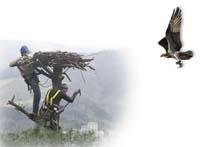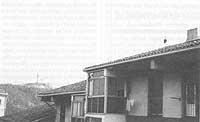In Urdaibai waiting to see storks on the way back
2009/04/01 Lakar Iraizoz, Oihane - Elhuyar Zientzia Iturria: Elhuyar aldizkaria
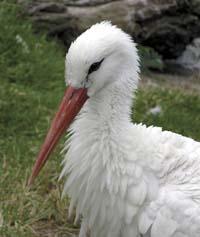
Stork collection infrastructure
The first work of the project was the construction of a size txoritegi for storks. The centre of Atxaga was built on a maritime public domain. The work was financed by the Provincial Council of Bizkaia and the Ministry of Environment and the City Council of Kortezubi authorized the construction of a center on the aforementioned plot.
The chorized has about one hundred square meters, is quite large for birds to develop their muscles, has areas of rest and the water source necessary to clean them.
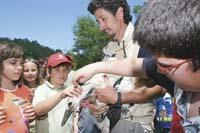
The storks to fill the txoritegi have been brought to Urdaibai from various wildlife recovery centers. Most are birds collected in the center of Vallcaliente, in Lleida, for the destruction of their nest, for the death of their parents, for the fall of the nest while studying to fly, or for any other reason that the public has taken to this center.
In general they have brought young storks. Aitor Galarza, head of the Ciconia project, explains why they have done so: "The storks are very philopatric, that is to say, even though during migration thousands of kilometers from their country of origin can be removed, they tend to return to their place of origin. And this philopatry is fixed when they are in the nest. However, while young people can change the area they consider as their birthplace." In this way they get that at the end of the migration the storks have the tendency to return to Urdaibai and not return to their true birthplace. "To achieve this, it is essential that the stork invests at least two winters in the new location," said Galarza.
In 2005, the first storks that had remained in the reintroduction centre in Urdaibai were released. In 2003 the "breeding" occurred and later, in 2007 and 2008, a new generation was released. Of course, two others in Urdaibai gave the time needed to adapt.
After liberation, what?
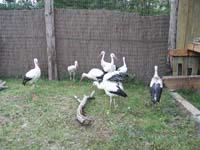
In total, 38 storks have been released. As Galarza said, "it is still too early to reach the general conclusions, but we have already seen three times what has happened with the released storks and we can cite some drafts of trends".
For example, they have seen that approximately half of the storks died in the first months since their release and that 80% died in the first week. Fourteen of them died less than three kilometers from the center.
Why did they die? Galarza tells us that seven of the deceased in the surroundings of the center died hitting some element of the electric network, trapped by four trains, one drowned, another intoxicated and the last shot dead.
In view of this, it can be said that when the captivity begins the real challenge for storks, and that is when the "competition" begins every day. The storks were released in spring, when they reproduce. In fact, these migratory birds spend spring-summer in our environment (throughout Europe in general), they reproduce here and at the end of summer they go to the sub-Saharan regions to spend the winter in tropical Africa.
When released, the storks were about two years old and usually begin to reproduce at three or four years. Therefore, despite being released in spring, newly released did not start looking for a couple, nidify, etc. Galarza explained to us that, however, they saw fit to free themselves at that time because "they were in a liberated environment, although they did not proliferate. And so there were more possibilities to return to the coming year."
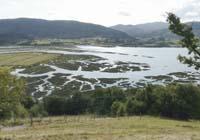
Once released, the storks, responding to the orders of their intuition, left Urdaibai. At the Urdaibai Foundation they were waiting for their return in the coming spring. Of all the liberates, only two of the first offspring appeared in Urdaibai. This was in 2006. One of the two returnees, a male, met in 2006 with a female who was not in the center of Urdaibai and was nidified. They seemed to have laid eggs and were going to have babies, but this did not happen.
The following year, in 2007, the couple of the previous year reappeared in Urdaibai at the time of breeding, and then they had two storks. And in 2008 they reunited and had two other children. They were the first storks born in Urdaibai in the last hundred years.
The rest of the storks have not returned to Urdaibai, but at the foundation they know, for example, that the five storks released in the project have not moved too far from Urdaibai to reproduce: they have discovered that two have reproduced in Amorebieta, one in Salburua and two in Cantabria. They also know that two released storks arrived in Arratia, where they have remained since then, that they have not migrated.
Storks sometimes make these decisions and spend the whole year where they reproduce. That, however, "not only occurs in the storks that were in captivity, but is also observed in the "natural" storks from time to time," says Galarza.
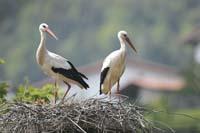
Encourage participation
Given that the storks generate sympathy for the citizenry, with the excuse of the storks, it has been tried to increase the awareness of conservationism among the population of the area. For this purpose, various activities have been organized: talks in nearby schools, participation of schoolchildren in all the activities of the project, Stork Parties in the times of liberation of the center, etc.
In fact, the stork is not itself a bird of great ecological importance, it is not a sensitive animal with certain needs, it is not a bioindicator of the ecological state of a certain medium… but it is an emblematic bird. It is large and has a special appearance, so it is easily separable and, in addition, lives around the human being: they nest in bells, chimneys of houses and higher trees of the parks. People in general contemplate them. And only that has opened the doors to receive help.
Likewise, through the project of storks, they have been able to make known the activity of the Urdaibai Foundation. On the one hand, the media of the area have shown much more interest for this project than for others of greater importance from an ecological point of view, such as the restoration and conservation projects of the native forest.
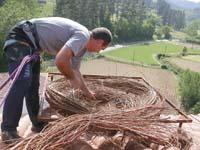
On the other hand, they have strengthened relations with several municipalities of Urdaibai and have managed to finance other conservation programs. Among others, they have been able to launch projects that aim to recover the marsh of Urdaibai.
As for the storks, they do not intend to bring more storks, the reintroduction program is finished. But they will continue to follow up and see if the effort made to introduce storks in Urdaibai bears fruit.

Gai honi buruzko eduki gehiago
Elhuyarrek garatutako teknologia



